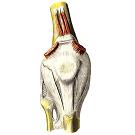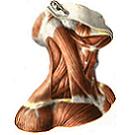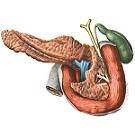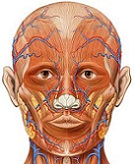Left ventricle
The left ventricle , ventriculus sinister, lies to the left, towards the posterior and downward in relation to the other parts of the heart. It has an oblong-oval shape.
The narrowed anterior section of the left ventricle corresponds to the apex of the heart. The external (left) edge of the left ventricle is rounded and called the pulmonary (lateral) surface, facies pulmonalis (lateralis).

The wall of the left ventricle reaches a thickness of 11-14 mm, mainly due to the myocardium.
The cavity of the left ventricle is longer and narrower than the cavity of the right ventricle. In the cross section, the cavity of the left ventricle near the apex of the heart represents a narrow slit, which, closer to the base, takes the shape of an oval.

In the cavity of the left ventricle, two divisions are distinguished: a wider posterolateral one is actually the cavity of the left ventricle and a narrower front right that is an extension of the cavity of the left ventricle. The posterior section communicates with the left atrial cavity by means of the left atrioventricular opening. It is smaller than the right atrioventricular aperture and more rounded. The anterior right section is connected with the aorta through the aortic opening, ostium aortae.

The left atrioventricular valve, valva atrioventricularis sinistra, is attached along the circumference of the left atrioventricular orifice. The free edges of its flaps extend into the cavity of the ventricle. This valve, with a contraction of the left ventricle, prevents the passage of blood back into the cavity of the left atrium.
In the valve distinguish the front leaf, cuspis anterior, and the posterior leaf, cuspis posterior. Between these valves are sometimes located two small teeth - commissural valves, cuspides comissurales.

The front flap, being strengthened on the anterior sections of the circumference of the left orifice, and also on the aortic aperture opening closest to it, is located to the right of the aorta than the posterior one. The free edges of the anterior valve are fixed by the tendon chords, chordae tendineae, to the anterior papillary muscle, m. Papillaris anterior, which starts from the anteroposterior cavity of the ventricle. The front leaf is slightly larger than the posterior. The posterior wing through the tendon chords is fixed mainly to the posterior papillary muscle, m. Papillaris posterior, which begins on the posterior wall of the ventricle.
The commissural valves, lying in the spaces between the large valves, are fixed by means of tendon chords either to papillary muscles, or directly to the ventricular wall.
In the valves of the left atrioventricular valve, as in the valves of the right valve, collagen, elastic fibers and a small number of muscle fibers associated with the muscle layer of the left atrium occur.
The anterior and posterior papillary muscles can each be divided into several papillary muscles. From the septum of the ventricles, as in the right ventricle, they begin very rarely.
The internal surface of the wall of the posterior part of the ventricle is covered with small protuberances - fleshy trabeculae, trabeculae carneae, which, intertwining with each other, form a network thicker at the apex of the heart, in the region of the interventricular septum. Trabeculae are less pronounced than in the right ventricle.
The anterior right section of the left ventricle cavity, passing through the aortic opening, ostium aortae, into the aorta, is located behind the arterial cone of the right ventricle, and, going up and to the right, crosses the latter. As a consequence, the aortic aperture lies somewhat posteriorly from the opening of the pulmonary trunk.

Along the circumference of the aortic aperture, three half-moon aortic flaps are attached, which, according to their position in the hole, are called right, left and posterior semilunar flaps, valvulae semilunares dextra, sinistra and posterior. Together they form the aortic valve, valva aortae.
Semilunar aortic flaps, like the semilunar flaps of the pulmonary trunk, are formed by the endocardial duplication, but are more developed. The nodule of the aortic flap, nodulus valvulae aortae, embedded in the thickness of each of them, is thicker and harder. The aortic flaps located on each side of the nodule are lunulae valvularum aortae, more sturdy.









Comments
When commenting on, remember that the content and tone of your message can hurt the feelings of real people, show respect and tolerance to your interlocutors even if you do not share their opinion, your behavior in the conditions of freedom of expression and anonymity provided by the Internet, changes Not only virtual, but also the real world. All comments are hidden from the index, spam is controlled.